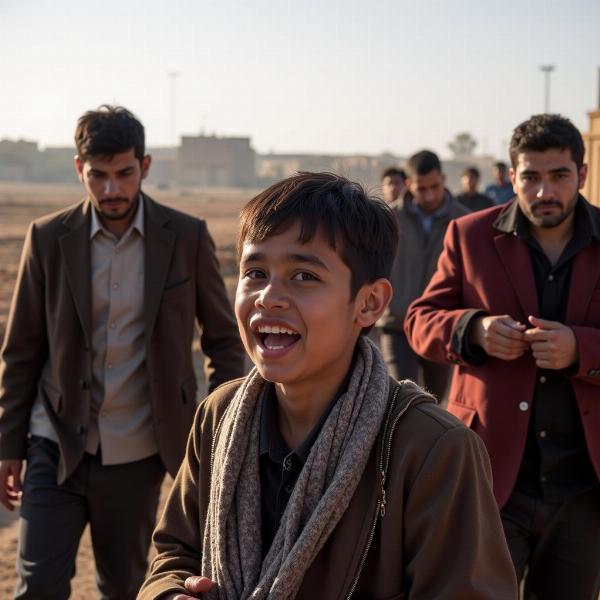Understanding the meaning of torture in Hindi goes beyond simple translation. It delves into the cultural nuances, legal interpretations, and societal perceptions surrounding this sensitive topic. While a direct translation might offer a superficial understanding, exploring the various Hindi words and phrases used to express the concept of torture reveals a deeper understanding of its significance in the Indian context. This article will explore the different facets of “meaning of torture in Hindi,” providing a comprehensive overview of its linguistic, cultural, and social implications.
Exploring the Hindi Words for Torture
Several Hindi words capture the essence of torture, each with its own specific connotations. These words reflect the different forms and degrees of torture, ranging from physical pain to mental anguish.
-
यातना (Yatna): This is perhaps the most common and direct translation of torture in Hindi. It encompasses both physical and mental suffering, often inflicted intentionally to extract information, punish, or intimidate. Think of the yatna endured by prisoners of war or victims of interrogation.
-
अत्याचार (Atyachar): This word carries a stronger connotation of oppression and cruelty. It suggests an abuse of power and often refers to systematic or widespread torture. Atyachar can be inflicted by individuals, groups, or even institutions. Consider the atyachar faced by marginalized communities subject to discrimination and violence.
-
कष्ट (Kasht): This term signifies suffering and hardship, which can encompass torture but is not limited to it. Kasht can also refer to emotional pain, financial difficulties, or physical ailments. The kasht experienced by refugees fleeing their homes is a poignant example.
 Suffering of Refugees
Suffering of Refugees -
पीड़ा (Peeda): This word refers to pain, agony, and torment, often associated with physical suffering. Peeda can be caused by torture but can also arise from illness or injury. Imagine the peeda experienced by someone undergoing a painful medical procedure.
-
प्रताड़ना (Prataadna): This term signifies harassment, persecution, and torment, often implying a sustained campaign of abuse. Prataadna can take many forms, including physical violence, psychological manipulation, and social ostracization. Consider the prataadna faced by whistleblowers who expose corruption and face retaliation.
Legal and Cultural Perspectives on Torture in India
India, as a signatory to the UN Convention against Torture, has legal frameworks in place to prohibit and punish torture. However, the implementation and enforcement of these laws remain a challenge. Culturally, torture is condemned in most Indian traditions and philosophies, which emphasize compassion and non-violence. However, instances of torture continue to occur, highlighting the gap between legal and societal ideals and the harsh realities on the ground.
How Meaning-Hindi.in Can Help
Understanding the nuances of language is crucial, especially when dealing with sensitive subjects like torture. If you need accurate and culturally sensitive translations related to legal, human rights, or social justice issues, Meaning-Hindi.in can provide expert assistance.
Torture in Literature and Film
Hindi literature and cinema often depict the realities of torture, exploring its psychological and social impact. These portrayals can raise awareness and spark dialogue about this critical issue.
What is the significance of understanding the various Hindi words for torture?
Understanding the nuances of these words allows for a more accurate and culturally sensitive interpretation of texts and discussions related to torture.
What are the legal implications of torture in India?
Torture is illegal in India, and various laws prohibit and punish acts of torture. However, enforcement and implementation remain significant challenges.
How does Indian culture view torture?
Most Indian traditions and philosophical schools condemn torture, emphasizing compassion and non-violence. However, the prevalence of torture highlights the disconnect between ideals and reality.
Conclusion
The “meaning of torture in Hindi” is a complex issue with linguistic, cultural, and legal dimensions. While words like yatna, atyachar, kasht, peeda, and prataadna capture different facets of torture, understanding their specific connotations is crucial for accurate and sensitive communication. Addressing this issue requires a multi-pronged approach involving legal reforms, social awareness, and cultural shifts. By understanding the language of torture, we can better address its root causes and work towards a more just and humane society.
FAQ
- What is the most common Hindi word for torture? Yatna (यातना) is generally the most frequently used term.
- Which Hindi word emphasizes oppression and cruelty in torture? Atyachar (अत्याचार) carries a stronger connotation of oppression and systematic abuse.
- Is torture legal in India? No, torture is illegal in India.
- How can I get accurate Hindi translations related to legal matters involving torture? Professional translation services like Meaning-Hindi.in can provide expert assistance.
- What role does Hindi literature and film play in portraying torture? They often depict the realities of torture, raising awareness and promoting dialogue on the issue.
Meaning-Hindi.in is your trusted partner for accurate and culturally sensitive Hindi translation services. We specialize in legal, business, technical, and website translation, ensuring your message resonates effectively with your target audience. Whether you need to translate legal documents, marketing materials, or educational content, our team of expert linguists is committed to delivering high-quality translations that meet your specific needs. Contact us today at [email protected] or +91 11-4502-7584 for a free quote and experience the Meaning-Hindi.in difference.